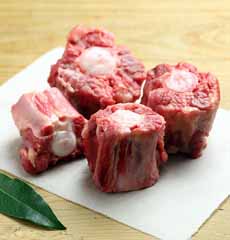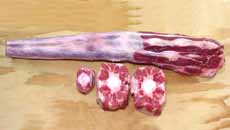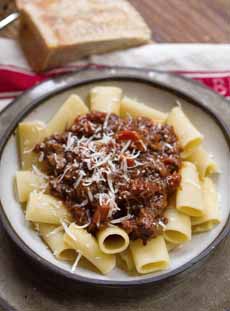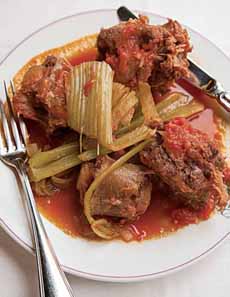TIP OF THE DAY: Oxtail (What Is It, How To Use It)
 [1] Oxtail is prized for its rich flavor and gelatinous texture (photo courtesy Abel And Cole).
|
In earlier times, when oxen did the heavy pulling of carts and plows, oxen who could no longer “pull their weight” became meat. In times when every scrap of food was precious*, every part of an animal (and vegetable) was used, from the head to the tail to to the hooves. Today, you can still buy oxtail (also spelled ox tail and ox-tail [photo #1]). It’s the tail of a cow or steer [photo #2]. Once considered food for poor people who couldn’t afford better cuts, chefs and home cooks alike have discovered the charms of oxtail. The price, accordingly, is no longer rock-bottom. The tail typically weighs 2 to 4 pounds. It is cut into short lengths, ideally 2-1/2 inches, by the butcher [photos #1 and #2]; although you can buy the entire tail and slice it yourself. The pieces are bony, fatty and gelatinous, the latter of which gives body to soups and stews. Each section includes some of the tailbone and its marrow, with meat and fat surrounding the tail. Oxtail is a tough cut that needs to be slow-cooked, typically in a stew, braise or soup. (Tip: Use a pressure cooker.) “Persevere,” says one butcher, “and you’ll be rewarded with one of the most tender bits of the cattle, with an intensely rich flavor.” Some recipes like stew serve the oxtail “on the bone” [photo #4]; others, like a ragu, specify that the meat be removed from the bones [photo #3]. But it’s not just tasty dishes: Beef stock and beef bouillon cubes are often made from oxtail. An ox is a bovine that is trained for draft work: pulling carts, wagons, plows, etc. Oxen can be either cows (female) or castrated bulls (steer); the latter were preferred for their greater strength. The males were castrated to make them gentler and thus easier to handle. Thus, there is no specific breed called “ox.” In Biblical times, ox was a term used for any domesticated bovine, regardless of age, gender, breed, type, or draft purpose [source]. Today’s description of bovines is much more complex. See how many terms you know. Oxen were the principal beasts of burden for millennia, and still are in less developed areas of the world. When oxen could no longer do their work and were slaughtered for food, it was discovered that the [castrated] males had a better flavor. That’s why steer are today’s source of quality beef. The term “oxtail” has retained its heritage, and to some of us sounds more exotic and appetizing than “cowtail” or “steertail.” Recipes abound online. Here are two to start you off: *And in many parts of the world, it still is. |
|
|
|
||





